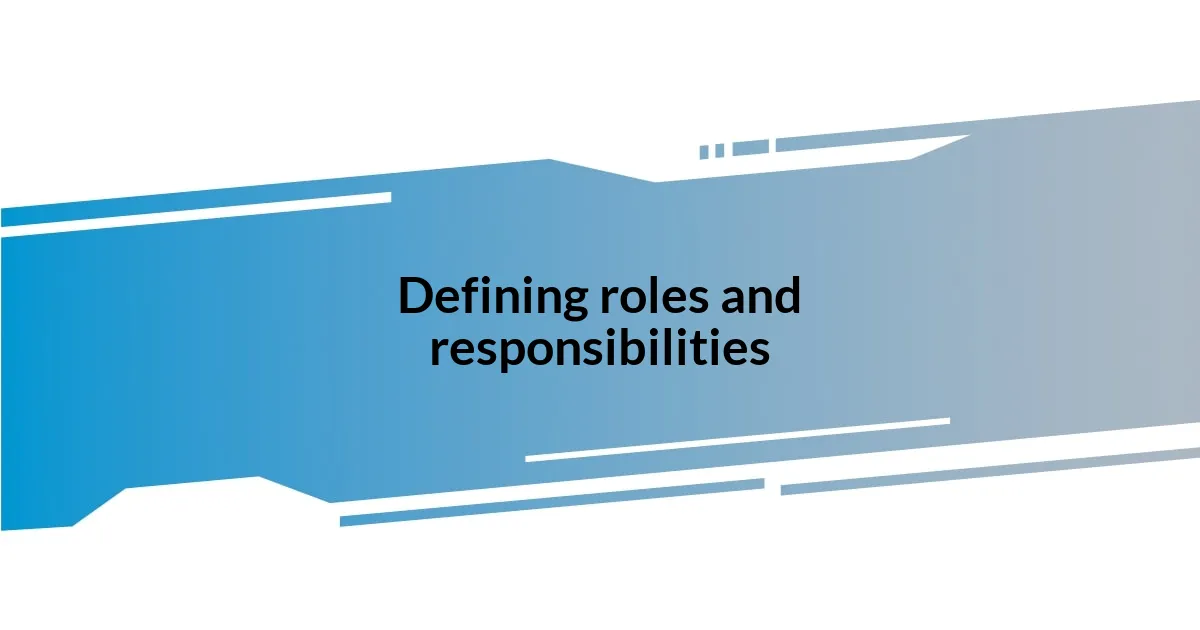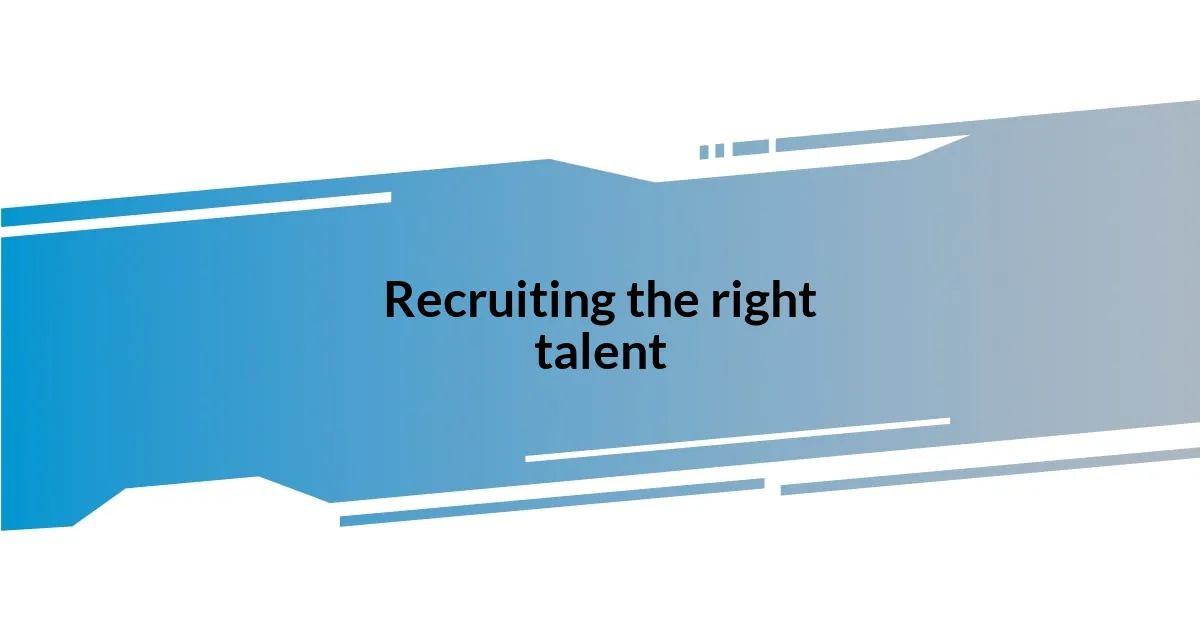Key takeaways:
- Engaging with cross-functional teams is essential for identifying compliance needs and enhancing understanding of regulations across the organization.
- Clear definitions of roles and responsibilities empower team members and foster a culture of accountability and ownership.
- Implementing training programs with relatable content and continuous feedback significantly improves compliance understanding and retention.
- Regular monitoring and continuous improvement through feedback loops and benchmarking are crucial for effective compliance management.

Identifying compliance team needs
When I first started evaluating the needs of my compliance team, I realized that it wasn’t just about filling roles—it was about understanding the specific gaps in our organization’s processes. Looking back, I remember a pivotal moment when a regulatory change left us scrambling. That experience highlighted for me that compliance isn’t static; it requires constant reassessment to ensure we’re equipped to handle evolving risks.
I also learned that engaging with cross-functional teams can unveil insights that may not be immediately apparent. For instance, during a meeting with the operations team, a common theme emerged: they struggled with understanding compliance requirements. This interaction sparked a realization for me: if the operations staff can’t grasp compliance nuances, how can we expect compliance to be effectively integrated into daily practices?
Reflecting on these experiences, I’ve come to believe that a thorough needs assessment begins with open dialogue. What do your stakeholders need? Are there existing pain points that, if addressed, could strengthen the team’s effectiveness? These questions guide my approach and encourage a culture of collaboration, ensuring compliance becomes a shared priority rather than a checkbox exercise.

Defining roles and responsibilities
Defining roles and responsibilities within a compliance team is crucial for ensuring that every aspect of compliance is managed effectively. I remember feeling overwhelmed when I first started bringing team members together. Each individual came with their own strengths and expertise, but without clear definitions, we often found ourselves duplicating efforts or overlooking critical tasks. I decided to have a brainstorming session where we could map out roles based on each person’s skills, ensuring a balanced distribution of responsibilities.
As we created our roles, I was struck by how much clarity emerged from our discussions. For instance, I noticed that while some team members excelled in research and analysis, others thrived in communication and training. Assigning these responsibilities not only optimized our workflow, but it also empowered team members to take ownership of their tasks. It was gratifying to see the pride they felt in their roles, which fostered greater accountability and collaboration.
The process wasn’t just pragmatic; it was deeply emotional for me. I often reflected on how empowering individuals to own their roles dramatically shifts the team dynamics. A well-defined structure promotes not just efficiency, but also morale. I realized that when individuals understand their responsibilities, it creates a sense of purpose that resonates throughout the team, ultimately influencing our compliance culture positively.
| Role | Responsibilities |
|---|---|
| Compliance Officer | Oversees compliance strategy and ensures regulations are met. |
| Training Coordinator | Develops and delivers training programs for staff on compliance topics. |
| Risk Analyst | Identifies potential compliance risks and analyzes their impact. |
| Documentation Specialist | Maintains all compliance documentation and records for audits. |

Recruiting the right talent
When it came to recruiting the right talent for my compliance team, I quickly learned that finding individuals with the right qualifications wasn’t enough. I remember an interview with a candidate who had impressive credentials but failed to demonstrate a proactive approach to problem-solving. That experience taught me to prioritize not only skill sets but also cultural fit and a passion for compliance. A blend of expertise and enthusiasm is essential.
In my journey, these are the key qualities I look for:
- Curiosity: A genuine interest in regulatory changes and their implications.
- Adaptability: The ability to pivot quickly as compliance requirements evolve.
- Communication Skills: The talent to convey complex regulations clearly to non-compliance staff.
- Integrity: A strong ethical compass to guide decisions and actions in often ambiguous situations.
Being selective about these traits has made a significant difference in building a cohesive team that not only meets compliance standards but also embraces them as part of the company culture.

Implementing training programs
Implementing effective training programs has been one of the cornerstones of our success in compliance. I vividly recall the first training session I developed; I wanted it to resonate, so I included real-life scenarios that my team could relate to. These relatable stories not only made the content engaging but also sparked discussions that helped to deepen our understanding. Isn’t it fascinating how practical examples can demystify complex regulations and enable a stronger grasp of compliance?
As I navigated the development of these programs, I learned the value of continuous feedback. After each training session, I’d ask participants what resonated with them and what didn’t. This not only boosted their engagement but also fueled my commitment to refine the training materials. I remember one team member saying they finally understood a complicated regulation thanks to a simple analogy I used. Moments like that reaffirmed for me that training is not just about delivering content; it’s about creating connections and fostering a culture of learning.
In my experience, blending traditional training methods with innovative approaches, like interactive workshops or gamification, has produced remarkable results. I experimented with role-playing exercises to simulate real compliance challenges; the enthusiasm in the room was palpable. Watching team members strategize together reminded me of how collaborative learning can enhance retention and application of knowledge. Have you considered how play can transform learning outcomes, even in a serious field like compliance? For me, it was a game-changer.

Establishing compliance processes
Establishing compliance processes involves creating a structured framework that aligns with both regulatory requirements and company values. I found that mapping out our compliance processes on a whiteboard helped visualize the intricacies involved. Seeing everything laid out spurred conversations about how each process could be more effective. It amazed me how a simple visual representation could clarify roles and responsibilities.
I firmly believe that collaboration is vital in developing these processes. When I invited team members from various departments to contribute their insights, it led to innovative solutions that I wouldn’t have considered on my own. I recall one meeting where a colleague pointed out a potential gap in our reporting process. That discussion not only bolstered our compliance but also reinforced a sense of shared ownership, which is crucial for adherence.
It’s also not enough to establish processes and just walk away. I learned that routine reviews and updates are essential to stay ahead of regulatory changes. I remember a time when we faced an unexpected audit due to a new regulation. Because we had a regular review system in place, we were able to respond swiftly and effectively, turning what could have been a crisis into an opportunity to showcase our commitment to compliance. How often do you think about the need for agility in your processes? For me, it’s an ongoing priority.

Monitoring and evaluation methods
Monitoring and evaluation methods are crucial for ensuring that compliance programs not only function but thrive. I remember the first time I implemented a tracking system to measure the effectiveness of our training sessions. It felt like opening a window into our team’s learning journey; suddenly I could see which topics resonated and which ones needed more attention. Have you ever witnessed the power of raw data transforming your decisions? For me, it was eye-opening.
Regular assessments and audits quickly became part of our routine. I couldn’t stress enough how valuable it is to engage in self-reflection and external audits. With one particular audit, I was surprised by the insights it revealed about our communication practices. It felt like being handed a mirror that not only showed our strengths but also illuminated areas for improvement. How often do we seek external perspectives to refine our internal practices? I’ve learned that such feedback can be a goldmine.
Moreover, I began incorporating real-time feedback mechanisms, such as anonymous surveys after trainings. Early on, I hesitated, fearing negative comments; instead, I was met with constructive criticism that was invaluable. One team member suggested we include more scenario-based learning options, which led to a redesign of our materials. Feeling the relief wash over me, I realized that open channels and a culture of transparency are like compass points guiding us toward better outcomes. How can you create a space where your team feels empowered to share their thoughts? That’s a conversation worth having.

Continuous improvement strategies
Continuous improvement strategies are at the heart of building an effective compliance team. One approach I embraced was to create a feedback loop. After implementing new processes, I initiated regular check-ins where team members could voice their experiences. I vividly remember one session where a junior staffer shared their frustration with a certain form that seemed overly complicated. Listening led us to simplify the form, increasing not only compliance but also team morale. It’s incredible how a small change can resonate across the team—have you ever noticed how a single voice can inspire a wave of improvements?
I can’t stress enough the importance of fostering a mindset that embraces change. Early on, I organized workshops that encouraged team members to brainstorm innovative ideas for enhancing our compliance efforts. In one memorable session, a team member proposed leveraging digital tools to automate reporting. We implemented this idea, and it not only saved us time but also reduced human error. Engaging your team in this way can turn compliance challenges into exciting opportunities for growth—don’t you think it’s exhilarating to watch a team flourish through collective creativity?
Lastly, I began to incorporate benchmarking as a continuous improvement strategy. Comparing our processes with industry standards opened my eyes to new possibilities. During one benchmarking review, I discovered that a competitor had successfully integrated compliance into their onboarding process. Inspired, I proposed a similar approach, ensuring that compliance was embedded from day one for new hires. Have you ever found inspiration by simply looking outward? It’s a reminder that the pursuit of improvement is ongoing; there’s always something new to learn.